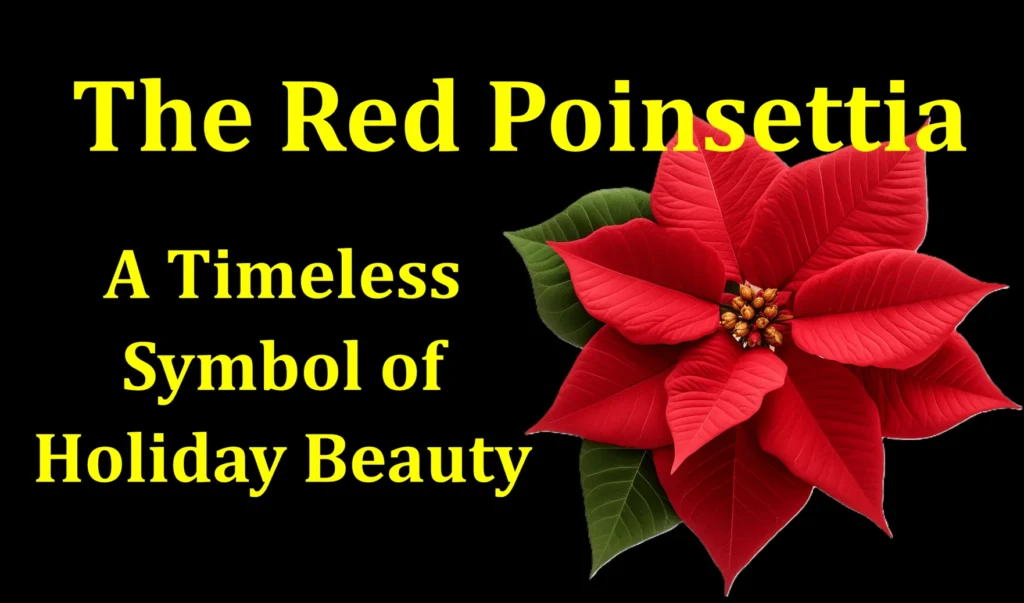
Introduction to the Red Poinsettia
The red poinsettia is a cherished emblem of the holiday season, with origins rooted in rich historical significance. Known botanically as Euphorbia pulcherrima, this vibrant plant has become an iconic representation of holiday cheer and festive traditions. Cultivated worldwide, the availability of this captivating flower ensures its prominence during the most wonderful time of the year.
Origins and Historical Significance
The origins of the red poinsettia can be traced back to Mexico, where it was highly regarded by the Aztecs. They called it “Cuetlaxochitl,” and it held great symbolic value to their civilization. Legend has it that a young girl who was too poor to present a gift to baby Jesus during a Christmas procession gathered weeds on her way to the church. Miraculously, these weeds transformed into breathtaking red poinsettias, forever intertwining the plant with the holiday season.
Iconic Association with the Holiday Season
No other flower encapsulates the essence of the holiday season quite like the red poinsettia. The brilliant sight of the leaves also known as bracts evokes a sense of warmth, happiness and excitement. For generations the red poinsettia has graced household’s places of worship and public areas, as a symbol of the spirit of Christmas. Adds a touch of natural elegance, to holiday adornments.
Cultivation and Availability
Throughout the years, cultivation techniques have allowed the red poinsettia to be widely available during the holiday season. Greenhouse growers skillfully nurture the plants, ensuring an ample supply for consumers. Poinsettias are commonly found in garden centers, nurseries, and even supermarkets, making it convenient for individuals to embrace the beauty and spirit of the season by incorporating these exquisite flowers into their own celebrations.
The Botanical Characteristics of the Red Poinsettia
Understanding the botanical aspects of the red poinsettia adds another layer of appreciation for this remarkable plant.
Plant Description and Structure
The red poinsettia is a deciduous shrub that typically grows up to two feet in height. It features succulent-like stems, adorned with elliptical, dark green leaves, which beautifully frame the radiant bracts. The plant’s structure showcases a striking symmetry, highlighting the intricacies of its design.
The Vibrant Red Leaves Called Bracts
The most captivating feature of the red poinsettia is undoubtedly its brilliant red bracts. Often mistaken for petals, these pigmented leaves surround the small, inconspicuous flowers at the center of the plant. The bracts can range in shades from deep crimson to vibrant scarlet, exuding a sense of splendor that perfectly harmonizes with the holiday ambiance.
Understanding the True Flowers of the Poinsettia
Contrary, to what many people think the red bracts of the poinsettia plant are not its flowers. The true flowers, called cyathia are yellowish structures found in the middle of the bracts. While they may seem inconspicuous compared to the flamboyant bracts, these true flowers play a vital role in the plant’s reproduction.
Cultural Significance and Symbolism of Red Poinsettias
The red poinsettia holds deep cultural significance and powerful symbolism, making it an integral part of various holiday traditions and celebrations around the world.
The Connection to Christmas Traditions
Red poinsettias have become synonymous with Christmas, spreading festive cheer and enriching the holiday spirit. Whether adorning homes, churches, or public spaces, the presence of these vibrant flowers accentuates the beauty and joy of the Christmas season. They symbolize hope, goodwill, and the gift-giving tradition that originated from the Christmas story.
Religious Significance and Representations
In symbolism the red poinsettia is frequently linked to the Star of Bethlehem. Symbolizes the arrival of Jesus Christ. The crimson hue signifies the blood of Christ, which holds significance in relation, to the nature of this holiday. The shape of the poinsettia’s bracts is also said to resemble the Star of Bethlehem, further accentuating its connection to the divine.

Poinsettias in Global Celebrations and Folklore
Beyond Christmas, red poinsettias have found their way into various global celebrations and folklore. In some cultures, it is believed that placing a poinsettia under your pillow can bring dreams of love and passion. In other traditions, poinsettias are associated with prosperity, wealth, and success. These cultural interpretations further perpetuate the universal admiration for the red poinsettia.
Caring for Red Poinsettias: Tips and Best Practices
To ensure the longevity and vibrancy of red poinsettias, proper care and attention are essential. Consider the following tips and best practices to keep these iconic plants thriving throughout the holiday season and beyond.
Light and Temperature Requirements
Red poinsettias thrive in bright, indirect light. It’s best to put them close to a window that lets in filtered sunlight. It’s really important to make sure the temperature stays within the range of 60 70°F (15 21°C). Try your best to avoid exposing the plant to changes, in temperature, like drafts or direct heat as it can harm its well-being.

Watering and Humidity Needs
It is crucial to water red poinsettias to ensure their health. Make sure the soil has a chance to dry out a bit, between waterings and be cautious not to overwater them as excessive moisture can cause root rot. Additionally, poinsettias appreciate humidity. Placing a tray filled with water near the plant or misting it regularly will help create the desirable humidity levels.
Pruning and Prolonging Bloom
To maintain a compact and bushy shape, periodic pruning is necessary. Pinch back the stems after blooming, leaving three to four leaves on each shoot. This promotes new growth and ensures a more robust plant in the following seasons. Additionally, if you desire poinsettias to rebloom next year, follow specific pruning and light exposure guidelines during the dormancy period (after the holiday season).
Red Poinsettias Beyond the Holiday Season
While red poinsettias have become synonymous with Christmas, their year-round appeal and versatility extend far beyond the holiday season.
The Versatility of Poinsettias as a Year-Round Plant
Contrary to popular belief, red poinsettias can be enjoyed beyond the holiday season. With proper care and attention, poinsettias can thrive as houseplants throughout the year, providing beauty and elegance to any indoor space. Their remarkable foliage and vibrant bracts can uplift the ambiance of any room, regardless of the season.
Uses in Home Decor and Landscaping
Red poinsettias are not limited to indoor decor alone. In regions, with weather these flowers can be incorporated into outdoor landscaping to bring bursts of color throughout the year lending charm and visual interest to gardens and landscapes. Additionally, their adaptability makes them perfect, for creating arrangements, wreaths and other decorative accents that elevate the overall look and feel of any area.
Creative and Unique Ways to Incorporate Poinsettias
Thinking outside the box, red poinsettias can be used as living centerpieces or focal points in creative displays. Integrating them with other seasonal foliage, such as pinecones, holly, or evergreen, can create visually striking arrangements. By embracing your creativity, you can incorporate poinsettias in unique ways that reflect your personal style and add a touch of charm to any setting.
Conclusion
The red poinsettia stands as a timeless symbol of holiday beauty, transcending cultures and captivating hearts around the world. Its history, cultural significance, and versatile charm make it an irresistible addition to festive celebrations. By embracing the art of caring for poinsettias and finding creative ways to incorporate their captivating presence beyond the holiday season, we can fully appreciate the enduring beauty and joy that these remarkable plants bring into our lives. So, this holiday season and beyond, let the red poinsettias dazzle, delight, and symbolize the everlasting spirit of Christmas.
Frequently Asked Questions (FAQs)
Can poinsettias survive outdoors?
Poinsettias can survive outdoors in suitable climate conditions.
1. Exploring Suitable Climate Conditions: Poinsettias thrive in mild climates where temperatures consistently stay above 55°F (13°C). They are particularly well-suited for growing in USDA hardiness zones 9-11, where frost and freezing temperatures are infrequent.
2. Outdoor Care Guidelines: When planting poinsettias outdoors, choose a site with well-draining soil and partial shade. Protect them from extreme heat and cold and provide regular watering to keep the soil evenly moist. Applying a layer of organic mulch around the base of the plant helps retain moisture and maintain a stable room temperature.
3. Overwintering Poinsettias: In locations with colder climates, poinsettias can be overwintered indoors. By following specific guidelines for temperature, light exposure, and pruning, you can successfully keep poinsettias healthy until the next growing season.Are poinsettias toxic to humans and pets?
Contrary to popular belief, poinsettias are not highly toxic to humans and pets.
1. Dispelling Common Misconceptions: Poinsettias have long been associated with toxicity; however, this is largely a misconception. While the plant does contain a milky sap that may cause mild irritation in some individuals, it is not known to be highly poisonous.
2. Understanding the Toxicity Level: According to the American Veterinary Medical Association (AVMA) poinsettias are mildly toxic, to cats and dogs. If pets happen to eat the plant it might cause problems such, as vomiting or diarrhea. However severe toxicity or fatalities are uncommon. Most instances of consumption only result in slight discomfort.
3. Precautions and Safety Measures: To make sure that pets and young children stay safe it’s still an idea to keep poinsettias out of their reach. Like, with any plant it’s important to avoid eating them and keep an eye out for any reactions. If accidental ingestion occurs, contact a healthcare professional or veterinarian for guidance.How can I make my poinsettia rebloom?
Making a poinsettia rebloom requires proper care during the dormancy period and specific light exposure.
1. Initiating the Dormancy Period: After the holiday season, allow your poinsettia to rest by reducing watering and providing it with a cooler environment. Place the plant in a room with a consistent temperature between 55-60°F (13-15°C) and limit exposure to natural light.
2. Correct Timing for Darkness Exposure: To trigger reblooming, poinsettias require a specific period of darkness. Approximately 12-14 hours of uninterrupted darkness daily for 8-10 weeks is necessary. It’s essential to maintain a strict light regimen during this period, as any exposure to light can hamper the flowering process.
3. Ensuring Proper Care During the Reblooming Process: While the poinsettia is in its dormancy period, continue minimal watering to prevent the soil from completely drying out. After the designated darkness period, gradually introduce the plant to brighter light and resume normal care. With patience and proper execution, your poinsettia should begin to rebloom, resulting in a beautiful display for the following holiday season.
